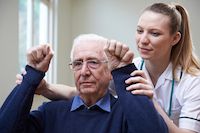Article
Intensive Versus Standard Treatment of Hyperglycemia in Stroke Patients
Author(s):
Results of the SHINE trial show no significant difference between standard and intensive treatment of hyperglycemia on functional outcomes following acute ischemic stroke.

Results of a randomized clinical trial offer further guidance for physicians on the most effective treatment of hyperglycemia in patients with acute ischemic stroke (AIS).
The Stroke Hyperglycemia Insulin Network Effort (SHINE), which examined outcomes with standard versus intensive treatment of hyperglycemia, found that no significant differences in functional outcomes between the 2 groups.


"This issue of glucose control for acute stroke patients has been hotly debated across the globe for decades. The SHINE trial has finally provided us with the evidence to drive practice," Karen Johnston, MD, chair of neurology and professor of public health sciences at the University of Virginia, told MD Magazine ®. "We now know that even though hyperglycemia in acute stroke patients is associated with worse outcomes, that intensive treatment of the glucose to force it into a normal range does NOT improve recovery and increases the risk of hypoglycemia."
To determine whether or not intensive treatment of hyperglycemia for up to 72 hours improved functional outcomes for patients, investigators from the University of Virginia carried out a randomized, clinical trial where more than 30,000 were assessed for eligibility. Patients in the trial were admitted at 1 of 63 US sites between April 2012 and Aug. 2018 — the follow-up period of the study lasted until Nov. 2018.
To be considered for inclusion, patients needed a National Institutes of Health Stroke Scale (NIHSS) score between 3 and 22 within 12 hours of stroke onset and had to be 18 or older at time of enrollment. Investigators defined hyperglycemia in patients with known type 2 diabetes as a glucose level greater than 110 mg/dL and a glucose level of 150 mg/dL in patients without known diabetes. Patients were considered indelible if they had type 1 diabetes, required renal dialysis, had a clinical indication for insulin infusion, or had a condition that would confound assessment of the stroke clinical outcome.
Of the 30,128 patients assessed for eligibility, a cohort of 1151 patients were randomized to receive either standard or intensive treatment. For the final analysis, 581 patients were randomized to receive intensive treatment and 570 were randomized to receive standard treatment.
Patients in the intensive treatment group received continuous intravenous insulin fusion as needed to maintain a blood glucose concentration of 80 to 130 mg/dL. The standard treatment group received insulin on a sliding scale, which was administered subcutaneously every 6 hours as needed, to maintain a blood glucose concentration of 80 to 179 mg/dL.
The primary efficacy outcome of the study was the proportion of patients with a favorable outcome 90 days after randomization. Investigators defined a favorable outcome as a modified Rankin Scale score of 0 among patients with a baseline NIHSS score of 3 to 7, a modified Rankin Scale score of 0 to 1 in patients with a baseline NIHSS score of 8 to 14, and a modified Rankin Scale score of 0 to 2 in patients with a baseline NIHSS score of 15 to 22. Secondary outcomes included 90-day NIHSS score, 90-day Barthel Index score, and 90-day Stroke Specific Quality of Life score.


Mean age of the 1,151 patients was 66 years, 46% of them were women, and 80% had diabetes. While 1,151 were included at baseline, a cohort of 1118 (97%) completed the study.
Investigators noted the mean blood glucose level in the intensive treatment group was 118 mg/dL and 179 mg/dL in the standard treatment group. Investigators observed a favorable outcome in 20.5% (119 of 581) of patients in the intensive treatment group and in 21.6% (123 of 570) of patients in the standard treatment group (adjusted relative risk, 0.97 [95% CI, 0.87 to 1.08], P = .55; unadjusted risk difference, −0.83% [95% CI, −5.72% to 4.06%]).


Additionally, treatment was discontinued for hypoglycemia or other adverse events in 11.2% (65 of 581) of the intensive treatment group and in 3.2% (18 of 570) in the standard treatment group. Investigators noted severe hypoglycemia occurred only among patients in the intensive treatment group. 


This study, titled “Intensive vs Standard Treatment of Hyperglycemia and Functional Outcome in Patients With Acute Ischemic Stroke,” is published in JAMA.





